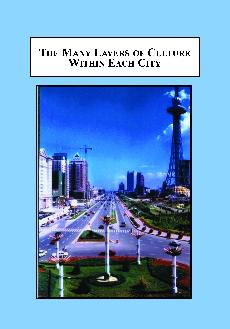The Many Layers of Culture Within Each City: A Theory of Cultural Geography
We are currently unable to ship to the EU countries at this time. We apologize for this inconvenience.

| Author: | St. Clair, Robert N. and Wei Song | |
| Year: | 2009 | |
| Pages: | 428 | |
| ISBN: | 0-7734-4646-X 978-0-7734-4646-5 | |
| Price: | $259.95 + shipping | |
| (Click the PayPal button to buy) | ||
Investigation explains how culture functions within several contexts of space. Cultural change involves the retaining of some cultural practices along with their modification, revision, and re-invention of events to accommodate the present. The past is redefined, restructured, revised, modified, and even re-invented in order to make it compatible with the interpretation of events within the cultural spaces of the present.
Reviews
“The study by Robert St. Clair and Wei Song is challenging, refreshing, and innovative. It is a timely and valuable addition to our concepts and understanding of culture. As argued by the authors, culture changes all the time and we need regularly to re-examine our concepts and understanding.” – Prof. Robert W. Vaagan, Oslo University
“There are several innovative and insightful contributions to be found in this volume. The authors have redefined the concept of culture to include both forms of knowledge (epistemology) and social practices (ontology). They argue that there are two sides to culture and both are bound in the form of reality-loops. The social construction of reality is confirmed through the use of these reality-loops. In addition, the authors have introduced the concept of cultural space in terms of layers of cultural time. Time, it is argued, is embedded within a cultural space. The present is embedded in the past and the future is embedded within the present. They refer to the co-present as the interface between the past and the present. It is in this interface that the past is redefined, revised, reinterpreted, or reinvented in order to adjust to the new configurations of meaning associated with the present.” – Prof. Yu Xin Jia, Harbin Institute of Technology
“Theory and practice come together as the reader can immediately apply the concepts of this book into his or her own city, into his or her own culture and ways of seeing the world. Culture is clearly understood as a “social practice”. It is active, lively and shapes the construction of the reality. In such a reality, people interact, using their language to communicate their symbols and perpetuate their values. Cities reflect not only geographical and historical aspects of a cultural space, but also beliefs of the people who live within.” – Prof. Ana Clotilde Thomé-Williams, Northwestern University
“There are several innovative and insightful contributions to be found in this volume. The authors have redefined the concept of culture to include both forms of knowledge (epistemology) and social practices (ontology). They argue that there are two sides to culture and both are bound in the form of reality-loops. The social construction of reality is confirmed through the use of these reality-loops. In addition, the authors have introduced the concept of cultural space in terms of layers of cultural time. Time, it is argued, is embedded within a cultural space. The present is embedded in the past and the future is embedded within the present. They refer to the co-present as the interface between the past and the present. It is in this interface that the past is redefined, revised, reinterpreted, or reinvented in order to adjust to the new configurations of meaning associated with the present.” – Prof. Yu Xin Jia, Harbin Institute of Technology
“Theory and practice come together as the reader can immediately apply the concepts of this book into his or her own city, into his or her own culture and ways of seeing the world. Culture is clearly understood as a “social practice”. It is active, lively and shapes the construction of the reality. In such a reality, people interact, using their language to communicate their symbols and perpetuate their values. Cities reflect not only geographical and historical aspects of a cultural space, but also beliefs of the people who live within.” – Prof. Ana Clotilde Thomé-Williams, Northwestern University
Table of Contents
Preface by Dr. Robert W. Vaagan
Acknowledgements
1. Cultural Space and Human Geography
2. The Framework of Cultural Space
3. The Theoretical Foundations
4. Culture as Social Practice
5. The Epistemological Realm of Practical Consciousness
6. The Ontological Realm of Practical Consciousness
7. Stratification Theory and Changing Societal Types
8. The Philosophy of Cultural Time
9. Modernization and the Cultural Space of Harbin
10. The Cultural Space of Rio de Janeiro, Brazil
11. The Cultural Space of Venice, Italy
12. The Cultural Space of Lisbon, Portugal
13. Concluding Remarks on the Theory of Cultural Space
Bibliography
Index
Acknowledgements
1. Cultural Space and Human Geography
2. The Framework of Cultural Space
3. The Theoretical Foundations
4. Culture as Social Practice
5. The Epistemological Realm of Practical Consciousness
6. The Ontological Realm of Practical Consciousness
7. Stratification Theory and Changing Societal Types
8. The Philosophy of Cultural Time
9. Modernization and the Cultural Space of Harbin
10. The Cultural Space of Rio de Janeiro, Brazil
11. The Cultural Space of Venice, Italy
12. The Cultural Space of Lisbon, Portugal
13. Concluding Remarks on the Theory of Cultural Space
Bibliography
Index
